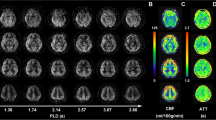Abstract
The aim of this study is to identify the pathophysiology of migraine attack with prolonged aura (between 1 h and 7 days) not clearly understood. We studied cortical cerebral microcirculation by an innovative near infrared spectroscopy system (NIRS) and cerebral macrocirculation by trancranial Doppler (TCD) in eight subjects (3 M and 5 F, age range 21–41 years) during spontaneous prolonged migraine aura and after 1, 2, 4, 6, 12 and 24 h since the end of aura and compared the results with the headache-free periods. During aura NIRS showed a significant decrease of the arterial pulse wave of cerebral microcirculation (APWCM) amplitude (−35%), p < 0.002, and an increase of cerebral tissue oxygen saturation (SctO2) (+15%), p < 0.008 ipsilateral to the headache pain and contralateral to the symptoms of aura compared with the headache-free periods; TCD showed a significant increase of pulsatility index (+38%), p < 0.001 and a significant decrease of the diastolic velocity in the posterior and middle cerebral artery ipsilateral to the headache pain and contralateral to the symptoms of aura compared with the headache-free periods. During prolonged migraine aura we found areas of cortical hypoperfusion corresponding to the topography of aura symptoms that were the result of a decreased metabolic demand rather than ischemic mechanism.
Similar content being viewed by others
References
Leão AAP (1944) Spreading depression of activity in the cerebral cortex. J Neurophysiol 7:359–390
Hadjikhani N, Sanchez Del Rio M, Wu O et al (2001) Mechanisms of migraine aura revealed by functional MRI in human visual cortex. Proc Natl Acad Sci USA 98:4687–4692
Andersson JL, Muhr C, Lilja A et al (1997) Regional cerebral blood flow and oxygen metabolism during migraine with and without aura. Cephalalgia 5:570–579
Zanette EM, Agnoli A, Roberti C et al (1992) Transcranial Doppler in spontaneous attacks of migraine. Stroke 23:680–685
Themelis G, D’Arceui H, Diamond SD et al (2007) Near-infrared spectroscopy measurement of the pulsatile component of cerebral blood flow and volume from arterial oscillations. J Biomed Opt 12(1):014033
Culver JP, Durduran T, Furuya D et al (2003) Diffuse optical tomography of cerebral blood flow, oxygenation, and metabolism in rat during focal ischemia. J Cereb Blood Flow Metab 23:911–924
Conflict of interest statement
The authors declare that they have no conflict of interest related to the publication of this article.
Author information
Authors and Affiliations
Corresponding author
Rights and permissions
About this article
Cite this article
Viola, S., Viola, P., Litterio, P. et al. Pathophysiology of migraine attack with prolonged aura revealed by transcranial Doppler and near infrared spectroscopy. Neurol Sci 31 (Suppl 1), 165–166 (2010). https://doi.org/10.1007/s10072-010-0318-1
Published:
Issue Date:
DOI: https://doi.org/10.1007/s10072-010-0318-1




